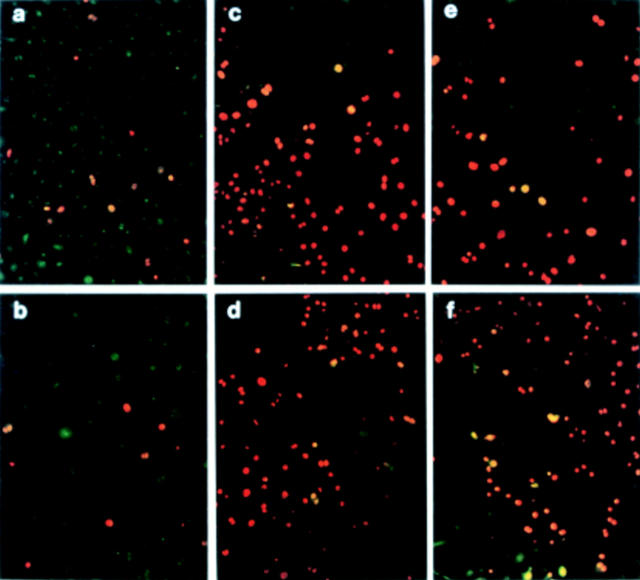Abstract
AIM—This study was designed to examine whether trehalose could protect corneal epithelial cells in culture from death by desiccation in order to test trehalose as a potential new eye drop for dry eye syndrome. METHODS—Human corneal epithelial cells in near confluent culture in wells of a 96 well multidish were preincubated for 15 minutes with 2, 20, 50, 100, or 200 mM trehalose or maltose in phosphate buffered saline (PBS), PBS alone, or three kinds of commercially available artificial tear substitutes (one with borate buffered saline and the other two containing either hydroxyethylcellulose or hyaluronan). The medium was aspirated completely and cells were left dry for 30 minutes at room temperature in room humidity. Live cells and dead cells were visualised by fluorescent dyes and counted for statistical analysis. RESULTS—The percentage of dead corneal epithelial cells after desiccation was significantly lower in preincubation with 50, 100, and 200 mM trehalose, compared with preincubation with PBS alone (p<0.0001, Kruskal-Wallis test, and p<0.05, Tukey-Kramer test). Trehalose at the concentration of 20 mM or lower, maltose at any concentrations, and commercially available artificial tear substitutes did not protect corneal epithelial cells from death by desiccation. CONCLUSIONS—Trehalose at 50, 100, and 200 mM protected corneal epithelial cells in culture from death by desiccation. Trehalose could be used as a potential new eye drop for dry eye syndrome.
Full Text
The Full Text of this article is available as a PDF (117.9 KB).
Figure 1 .
Live cells (green) and dead cells (orange) after 30 minute desiccation visualised by LIVE/DEAD Reduced Biohazard Viability/Cytotoxicity Kit (Molecular Probe). The number of dead cells is smaller after preincubation with 200 mM trehalose (a) and 100 mM trehalose (b), compared with preincubation with 200 mM maltose (c), 100 mM maltose (d), 0.1% hyaluronan (e), and phosphate buffered saline (f).
Selected References
These references are in PubMed. This may not be the complete list of references from this article.
- Allison S. D., Chang B., Randolph T. W., Carpenter J. F. Hydrogen bonding between sugar and protein is responsible for inhibition of dehydration-induced protein unfolding. Arch Biochem Biophys. 1999 May 15;365(2):289–298. doi: 10.1006/abbi.1999.1175. [DOI] [PubMed] [Google Scholar]
- Crowe J. H., Carpenter J. F., Crowe L. M. The role of vitrification in anhydrobiosis. Annu Rev Physiol. 1998;60:73–103. doi: 10.1146/annurev.physiol.60.1.73. [DOI] [PubMed] [Google Scholar]
- Crowe J. H., Crowe L. M., Carpenter J. F., Aurell Wistrom C. Stabilization of dry phospholipid bilayers and proteins by sugars. Biochem J. 1987 Feb 15;242(1):1–10. doi: 10.1042/bj2420001. [DOI] [PMC free article] [PubMed] [Google Scholar]
- Crowe J. H., Hoekstra F. A., Crowe L. M. Anhydrobiosis. Annu Rev Physiol. 1992;54:579–599. doi: 10.1146/annurev.ph.54.030192.003051. [DOI] [PubMed] [Google Scholar]
- Guo N., Puhlev I., Brown D. R., Mansbridge J., Levine F. Trehalose expression confers desiccation tolerance on human cells. Nat Biotechnol. 2000 Feb;18(2):168–171. doi: 10.1038/72616. [DOI] [PubMed] [Google Scholar]
- Leslie S. B., Israeli E., Lighthart B., Crowe J. H., Crowe L. M. Trehalose and sucrose protect both membranes and proteins in intact bacteria during drying. Appl Environ Microbiol. 1995 Oct;61(10):3592–3597. doi: 10.1128/aem.61.10.3592-3597.1995. [DOI] [PMC free article] [PubMed] [Google Scholar]
- McCarty C. A., Bansal A. K., Livingston P. M., Stanislavsky Y. L., Taylor H. R. The epidemiology of dry eye in Melbourne, Australia. Ophthalmology. 1998 Jun;105(6):1114–1119. doi: 10.1016/S0161-6420(98)96016-X. [DOI] [PubMed] [Google Scholar]
- Shimmura S., Ono M., Shinozaki K., Toda I., Takamura E., Mashima Y., Tsubota K. Sodium hyaluronate eyedrops in the treatment of dry eyes. Br J Ophthalmol. 1995 Nov;79(11):1007–1011. doi: 10.1136/bjo.79.11.1007. [DOI] [PMC free article] [PubMed] [Google Scholar]



